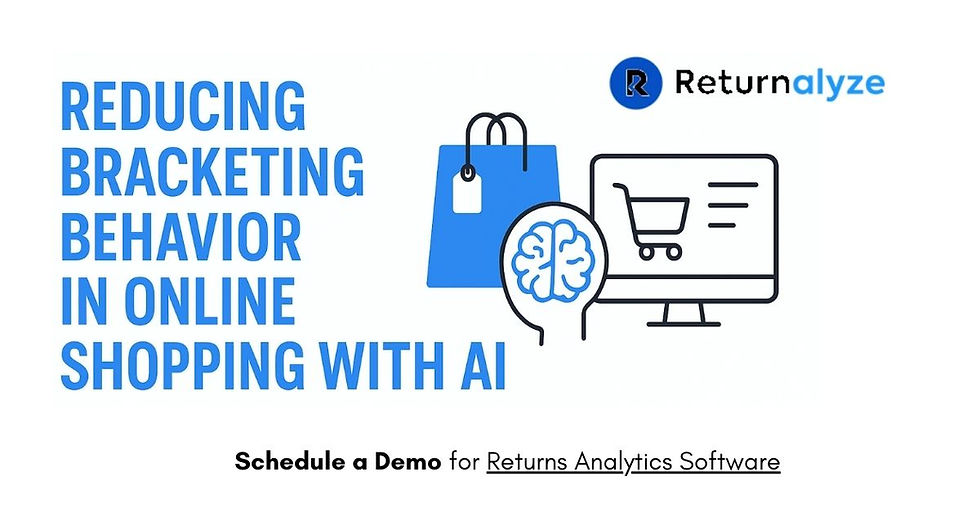Reducing Bracketing Behavior in Online Shopping with AI
- returnalyze
- Sep 28, 2025
- 4 min read

Online shopping continues to grow rapidly, but with this growth comes an equally concerning trend: bracketing behavior. Customers often purchase multiple sizes, colors, or styles of the same product with the intention of returning what doesn’t fit or meet expectations. While this practice gives shoppers confidence, it creates a heavy burden on retailers in terms of logistics, rising costs, and environmental impact.
Fortunately, AI-driven returns analytics is emerging as a powerful solution to help retailers predict, prevent, and reduce bracketing behavior. By understanding customer intent, improving pre-purchase decision-making, and optimizing the post-purchase journey, retailers can transform bracketing from a costly challenge into a manageable, data-driven opportunity.
What Is Bracketing Behavior?
Bracketing in e-commerce refers to when shoppers order multiple variations of a product - like three different shoe sizes or two shades of the same jacket - planning to keep just one. This behavior has become particularly common in categories like fashion, footwear, and apparel, where product fit and sizing can be difficult to determine online.
While bracketing helps shoppers feel confident about their choices, it has significant downsides for retailers:
Increased return rates and higher reverse logistics costs.
Difficulty forecasting inventory and demand.
Lower operational efficiency due to restocking and repackaging.
Reduced profit margins and hidden revenue leakage.
Why Do Shoppers Bracket Purchases?
To reduce bracketing, retailers first need to understand what drives the behavior. Common reasons include:
Uncertainty about fit and sizing in categories like apparel.
Inconsistent product descriptions or imagery that fail to set the right expectations.
Lack of trust in quality when purchasing from new brands.
The rise of “free returns” policies that encourage risk-free ordering.
Without addressing these challenges, retailers will continue to see a significant portion of orders come back as returns. This is where AI-powered returns prevention strategies step in.
How AI Reduces Bracketing Behavior
1. AI-Driven Fit and Size Recommendations
One of the most effective applications of AI in e-commerce is personalized fit intelligence. By analyzing a shopper’s past purchases, returns history, and body measurements (if available), AI can predict the best-fitting size before the customer checks out.
Retailers using AI-powered size recommendations have seen a sharp decrease in bracketing, as customers are less likely to order multiple sizes “just in case.”
2. Predictive Analytics to Identify High-Risk Orders
Through predictive return analytics, retailers can flag high-risk orders that have a higher likelihood of being bracketed. For instance, if a customer repeatedly buys three sizes of the same item and returns two, AI models can identify the pattern.
This insight allows retailers to take proactive measures, such as offering targeted fit guidance, adjusting product recommendations, or limiting excessive bracketing behavior with policy adjustments.
3. Enhanced Product Descriptions and Visuals with AI
Shoppers often bracket because they are unsure of product details. AI can generate and optimize product descriptions, images, and videos to better represent fit, texture, and use cases. Generative AI can also simulate “try-on” experiences, giving customers more confidence in their selection.
By bridging the gap between expectation and reality, retailers reduce the chances of customers over-ordering.
4. Personalization Through AI-Powered Merchandising
Personalization is at the heart of reducing returns. With AI-driven product recommendations, retailers can match customers with items that align with their preferences, purchase history, and style. When shoppers feel that a product is “made for them,” the need to order multiple variations decreases.
5. Monitoring and Optimizing Returns Policies
AI analytics can also help retailers strike the right balance between offering flexible returns policies and discouraging excessive bracketing. By segmenting customers based on return patterns, brands can reward loyal, low-return customers while discouraging chronic bracketing behavior with stricter policies or educational nudges.
Benefits of Reducing Bracketing with AI
Retailers who leverage AI returns management software see measurable benefits:
Lower return rates, reducing shipping and restocking expenses.
Improved customer satisfaction, since AI reduces the frustration of receiving poorly fitting or misrepresented products.
Increased profitability, as fewer returns mean more retained revenue.
Sustainable retail practices, with fewer unnecessary shipments lowering carbon footprint.
By adopting AI-driven strategies, brands can move from being reactive about returns to proactively preventing them.
Future of AI in Returns Prevention
The future of e-commerce lies in smarter, data-backed decisions. With AI in retail analytics, brands can go beyond simply processing returns - they can predict customer behavior, optimize product experiences, and prevent unnecessary returns before they happen.
As AI models become more sophisticated, retailers will be able to detect not just “what” customers are returning, but “why” they are returning it. This insight will fuel product innovation, better merchandising, and more sustainable shopping experiences.
Final Thoughts
Bracketing behavior may feel like an inevitable part of online shopping, but with AI-driven returns analytics, it doesn’t have to be. By combining predictive insights, personalization, and smarter product data, retailers can reduce unnecessary returns, protect margins, and deliver better shopping experiences.
At Returnalyze, we help leading retail brands uncover hidden revenue opportunities, improve profitability, and transform returns from a cost center into a competitive advantage.
👉 Ready to reduce bracketing and turn returns into revenue? Connect with Returnalyze today.



Comments